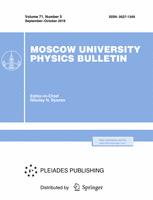Annotation
We consider the static, dynamic and modulation methods of measurement of the second derivatives of the gravitational potential by using a high-quality mass-quadrupole oscillator. It is assumed that the useful signal is masked by the noise of the displacement indicator, or by the Brownian oscillations of the oscillator. We present algorithms for the analysis of the output signals which correspond to the method of maximum of a probability function, and we obtain formulae for the dispersion of estimates of the second derivatives of the potential,i.e., for the instrumental and thermal limits of accuracy of various methods of measurements. The obtained results make it possible to make conclusions about the advantages of the modulation method.
© 2016 Publisher M.V.Lomonosov Moscow State University
Authors
V.S. Nazarenkо
Sternberg Astronomical Institute, Moscow State University Universitetsky pr., 13, Moscow 119234, Russia
Sternberg Astronomical Institute, Moscow State University Universitetsky pr., 13, Moscow 119234, Russia



